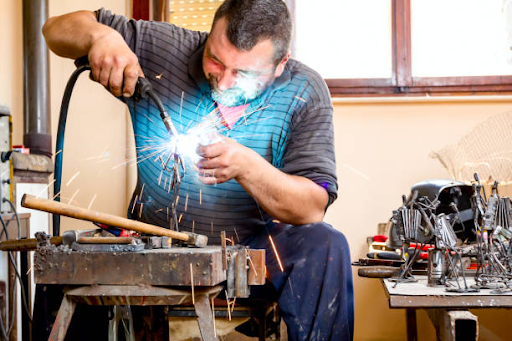MIG welding has long been a favorite for both beginners and seasoned professionals because of its speed, efficiency, and versatility. However, simply owning a MIG welder does not guarantee top-notch results. To truly get the best MIG welds, you must optimize your techniques and machine settings. Even the most minor tweaks, from adjusting the voltage to fine-tuning the wire feed speed, can significantly impact the outcome. Besides, there are practical steps you can take to reduce spatter, avoid burn-through, and create clean, strong welds every time. So, in this article, we’ll dive into what MIG welding is and share practical tips to help you optimize your MIG welding performance, ensuring you get better results every time you fire it up.
What Is MIG Welding?
MIG welding, also called Metal Inert Gas welding, is one of the most widely used welding techniques. Its popularity stems from how easy it is to pick up and the solid and reliable results it delivers. Whether you’re a beginner or a seasoned welder, MIG welding is known for being fast and efficient. Here’s a breakdown of how it works and what makes it so effective.
How Does MIG Welding Work?

welder MIG welding in a factory
MIG welding uses a welding gun that continuously feeds a wire electrode. The heat from the arc melts this wire, fusing the metals you’re working on. The wire becomes the filler material, creating the weld that bonds your parts. The setup for MIG welding is relatively straightforward. Just connect your power source, load the wire, attach the gas cylinder, and you’re good to go. For these reasons, it’s a go-to for welders who need to work quickly.
The shielding gas is one key factor that sets MIG welding apart from other methods. This gas, usually argon or a mixture of argon and CO2, protects the weld from air contaminants. Without shielding gas, oxygen, nitrogen, and moisture can enter the weld pool, causing oxidation, porosity, or weak welds. The gas creates a protective bubble around the weld, ensuring that your welds are strong and clean.
MIG welding also stands out because of its ability to work on various metals, from steel to aluminum. This flexibility allows welders to take on multiple projects with just one machine. Unlike other welding methods that require more skill, MIG welding gives you more control. Set the correct voltage and wire feed speed, and you’re ready. Plus, because it uses a spool of wire, there’s no need to stop and change rods like in stick welding constantly. This makes it much more efficient, especially for large projects.
MIG welding commonly applies in various industries because of its adaptability and reliability. Check the applications below:
- Automotive repair: MIG welding is widely used in the automotive industry, particularly for bodywork and repairs. Its precision and speed make it ideal for these tasks.
- Construction and manufacturing: MIG welding is prized for its strength and quick turnaround times in heavy-duty sectors like construction and manufacturing.
- DIY and hobbyist projects: MIG welding offers a simple way to create strong, clean welds, even for small-scale projects or metal art.
Tips to Get the Most from Your MIG Welders

a sculptor using MIG welding to assembly metal sculpture
MIG welding is known for being one of the most straightforward welding processes to learn, but getting the most out of your welder still takes some know-how. Whether you’re new to welding or have been at it for years, the tips below will help you fine-tune your MIG welder for cleaner, stronger, and more efficient welds.
Choose the Right Gas Mix
Gas selection is critical to the quality of your weld. The type of shielding gas you use directly affects how the arc behaves, the cleanliness of the weld, and even the amount of spatter you have to deal with. For most mild steel projects, a gas mixture of 75% argon and 25% CO₂ is an excellent choice. This mix gives you a stable arc, reduces spatter, and provides good penetration. However, if you’re welding stainless steel, consider using a blend of argon with a small percentage of CO₂ or oxygen. For aluminum, you’ll want 100% argon. The correct gas mix minimizes post-weld cleanup and gives you a smoother, more reliable weld.
Dial in Your Wire Speed and Voltage
Wire speed and voltage are the two main settings that control your welding arc. You’ll have a mess of spatter and inconsistent welds when you use too much wire. Conversely, using too little wire creates an erratic arc that’s hard to control. So, start by consulting your welder’s manual, which typically provides recommended settings based on the material thickness and wire size. Once you begin welding, make minor adjustments as you weld, and try listening to the sound of the arc. If it’s popping or sputtering, you must tweak your settings until the arc smooths out.
Clean the Workpiece Thoroughly
A clean work surface is crucial to a strong weld. Contaminants like rust, dirt, grease, and paint can interfere with the arc and result in a weak, porous weld. Even if you’re in a hurry, take the time to clean the metal before you start welding. Use a wire brush, grinder, or sandpaper to remove surface imperfections. For aluminum, oxidation forms quickly, so it’s best to clean the material before welding. A clean surface helps your weld penetrate deeper, and you’ll get fewer defects, making your welds more robust and reliable.
Pick the Right Wire for the Job
The wire you use in your MIG welder must match the material and the gas mix you’re working with. For mild steel, an ER70S-6 wire is a solid choice. This wire works well with a CO₂ or argon mix and handles rusty or dirty surfaces better than other options. When welding stainless steel, you’ll need a wire specifically designed for that, such as ER308L. Aluminum requires a soft wire like ER4043, paired with 100% argon as your shielding gas. Always double-check your wire type to ensure it’s compatible with the material, gas, and application.
Maintain a Consistent Travel Speed
How fast you move the welding gun across the joint, or the travel speed, plays a massive role in how your welds turn out. Moving too fast results in poor penetration and weak welds, while moving too slowly can lead to excessive buildup and an ugly weld bead. You want to aim for a smooth, consistent motion. Practice is critical here, so start by finding a comfortable rhythm and adjust as you go. You’ll know you’ve got it right when you see a steady, uniform bead that doesn’t pile up or look too thin.
Control Your Stick-Out Distance
Stick-out refers to how much wire extends from the nozzle to the workpiece before welding. A good rule of thumb is to aim for about 3/8 to 1/2 inch of stick-out. If the wire is too short, it can burn back into the contact tip, creating more downtime and frustration. If the stick-out is too long, you’ll lose control over the arc, which can lead to excessive spatter and an unstable weld. Keeping a steady stick-out ensures a smooth arc and better overall control of the weld puddle.
Maintain the Right Torch Angle
The angle at which you hold the torch also affects weld quality. Ideally, you should hold the torch at a 10 to 15-degree angle, leaning into the direction of the weld. This helps direct the heat and arc force into the joint, ensuring good penetration and a smooth, even bead. For flat welds, a slight drag or push angle works best. Maintaining a consistent angle becomes even more critical when working on vertical or overhead positions to prevent the weld from sagging or dripping.
Keep Your MIG Welder in Top Shape
Your MIG welder also requires routine maintenance to stay in top condition. Start by inspecting your consumables, such as the contact tip, nozzle, and liner, which wear out over time. Clean any slag or spatter from the nozzle and replace worn parts before they cause issues. It’s also essential to keep your wire clean and dry, as rusty wire can lead to feeding problems and poor weld quality. Regularly check the gas flow, wire feed rollers, and power cables to ensure everything functions smoothly. Well-maintained equipment produces better welds and reduces downtime.
Conclusion
Optimizing MIG welding performance comes down to the right combination of tools, techniques, and maintenance. Steps like selecting the proper gas mix and wire and maintaining a consistent torch angle and travel speed are crucial in getting clean, strong welds. Moreover, keeping your workpiece clean and your equipment in top shape ensures the best results, no matter the project. With these tips, you’ll get the most out of your MIG welder and improve your overall welding quality.
Take your welding projects to the next level with Zintilon’s unmatched expertise. At Zintilon, we deliver top-tier precision and quality for all your welding needs every time. Contact us today and experience the difference with our professional MIG welding service!










